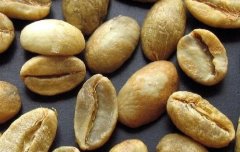Arabica Robusta coffee beans
In terms of varieties, coffee trees are mainly divided into two types: one is Arabica, the other is Robusta.
Arabica
Robusta
Mostly found in tropical Central and South America
Of Madagascar in west-central and eastern Africa and Indonesia in Asia
Planted on an alpine slope at an altitude of 900 mi 2000 meters.
Planted on an alpine slope at an altitude of 200 Mel 600 meters above sea level
Need a high degree of manual intensive care
By contrast, it doesn't take much manpower.
The taste is rich.
The taste is poor and bitter.
Low caffeine content
The caffeine content is about twice that of Arabica.
The price is higher
The price is lower
The shape of the bean is small, the front is long oval, the middle crack is narrow and tortuous, and the arc on the back of the bean is smooth.
The bean shape is larger, the front is gradually round, and the back is round and straight, a bit like barley seed.
Since coffee fruits are not ripe on the same tree at the same time, high-quality coffee must be picked by hand. About 75 per cent of the world's coffee is Arabica, but only 10 per cent is coffee that can be used in high-end coffee shops. If coffee beans produced from one country or region have not been mixed with other coffee beans, we call them single-source coffee beans.
The types of Arabica coffee trees include: Bourbon,Typica,New modern nybrids caturra, Catimor and Variedad Colobiana.
Growing environment: coffee grows in a treeless climate with medium rainfall and plenty of sunshine. The main coffee growing regions in the world are the Americas, Africa, the Arab region and Indonesia. Coffee is grown in about 80 countries in these regions.
Important Notice :
前街咖啡 FrontStreet Coffee has moved to new addredd:
FrontStreet Coffee Address: 315,Donghua East Road,GuangZhou
Tel:020 38364473
- Prev

Introduction of high-quality and well-known coffee raw beans
Ethiopia (Ethiopia) Mocha Coffee Raw Bean Ethiopia mocha green bean Arabica Coffee is the hometown of Arabica Coffee, which grows at high latitudes and requires a lot of manual care. Here is the famous Ethiopian mocha, which has a sour taste similar to that of wine, fragrant and productive. Ethiopia also passes through its neighboring countries across the Red Sea.
- Next

Coffee, raw beans, fine coffee, raw beans
From the fruit state of coffee beans when they are picked from the tree to the state of raw beans that can be baked, the moisture content of coffee beans will be controlled between 9% and 13%, and it is not easy to bake if the water content is too high or too low. Generally, we get newly collected raw beans with water washing treatment, the moisture content is usually about 11.5% to 12.5%, half-washed Mantenin may reach 13%, and half-washed Brazil is 11% ~ 12% per day.
Related
- Guji coffee producing area of Guji, Ethiopia: Humbela, Shakiso, Wulaga
- What is the most expensive variety of Qiloso in BOP multi-variety group?
- How to store the coffee beans bought home?
- Why are Yemeni coffee beans so rare now?
- Ethiopian Sidamo all Red Fruit Sun Sun Santa Vini Coffee beans
- SOE is mostly sour? What does it mean? Is it a single bean? what's the difference between it and Italian blending?
- Is Italian coffee beans suitable for making hand-brewed coffee?
- How to choose coffee beans when making cold coffee? What kind of coffee beans are suitable for making cold coffee?
- Just entered the pit to make coffee, what kind of coffee beans should be chosen?
- Can only Japan buy real Blue Mountain Coffee? What are authentic Jamaican Blue Mountain coffee beans?

